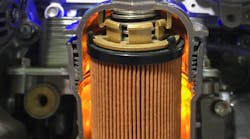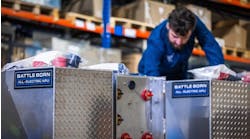Filter maintenance strategies used to be reactive. A fleet would find out whether it had a good or bad filter after changing it out during the normal replacement interval, or in the worst-case scenario after a system failure. Those days are gone. Through advanced sensor technologies and data analytics, fleets can now better maintain filters, ensure they are working at optimal levels, and predict failure before a crisis arises.
In short, these tools help fleets not only achieve better air and fluid flow but a better workflow as well. At the end of the day, the best filter maintenance program comes down to visibility, said Chris Scott, CEO of Senzit, a provider of smart engine monitoring devices.
“Fleet managers need a quick and easy way to view the performance of their equipment in the field to make better decisions,” Scott said. “They’re tasked with maintaining steady-state operations. And one study found filtration being a cause of about 50% of all downtime. That’s why it’s critical to know what’s happening underneath the hood and in your filtration system.”
Due to sensor innovations, that visibility includes foresight—seeing potential issues ahead of time and keeping broken equipment from clogging up maintenance bays. Scott said the industry has seen the overarching shift from reactive to preventive maintenance, and the trend has been magnified over the last few years due to COVID, the labor shortage, and the supply chain crisis.
Where to start?
Before getting into the high-tech monitoring solutions, a fleet needs to first select the filter itself.
Filter media play a big role in ROI. According to Nate Neudecker, product manager of engine air aftermarket at Donaldson, the filter manufacturer found that a fleet of 600 or more trucks could save $100,000 annually using its premium PowerCore air filters. Donaldson claims these media offer 13% to 26% better dust-loading than competitor brands, with 27% to 49% lower initial restriction. Better airflow equals better fuel efficiency and fewer filter changes.
Chris Reamsnyder, VP of sales at Dorman Products, explained that filtration media impacts capacity, efficiency, and restriction. And the containers for these media have gone through a lot of innovation.
“Many of the liquid systems have transitioned to patented cartridge-style designs, while others have maintained a spin-on configuration but have incorporated unique mounting plates,” he said, adding that “spin-on” filters that use a common thread size are becoming less common. “Regardless, most are using a greater percentage of synthetic-based fibers in the media to improve filtration performance and drive toward extended drains.”
Air filters have also changed, Reamsnyder noted. “Axial load filters transitioned to radial seal filters, and now the trend is aligning with channel media versus traditional pleated designs.”
Both the channel style and precision pleat equivalent have allowed filter makers to optimize the media density, he said. “In doing so, the size of the filter has been reduced significantly while ensuring the same level of life/capacity,” he said. “Further, constraints on filter shapes have been redefined. As expected, the new technology comes at an expense, and patents have limited competitive alternatives.”
Donald Chilton, director of product management at MANN+HUMMEL, the parent company of Senzit and WIX Filters, agreed that filter media innovations have increased in recent years.
“The important thing to know is that this cannot always be seen by the eye, but rather, the results show in the performance on the road and in the lab,” he said.
Improving PMs to increase uptime
A proper PM strategy must complement these innovative new filters.
“Having a well-planned maintenance schedule, as it pertains to filtration, ensures fleet uptime,” Dorman’s Reamsnyder said. “It starts by aligning with a strong distribution or installer partner that knows your fleet and will have the parts ready when you need them.”
“Essentially, plan your work, then work your plan,” he advised. “In doing so, you will ensure uptime and optimize profitability.”
One air filtration trend Reamsnyder warned against was getting ahead of schedule and changing filters too frequently.
“Some may believe that it is better to change the air filter more often than required,” he said. “This is poor practice. Not only do you increase the probability of introducing contaminants every time you remove the filter from the housing, an air filter is most efficient after a ‘dust cake’ is formed on the surface of the media.”
Garco Construction didn’t have a strict maintenance program in place and had little visibility into the condition of their air filters. The company, headquartered in Spokane, Washington, with a mixed fleet of more than 200 machines, relied on manual engine hour tracking and changing the air filter whether the machine needed it or not. This practice meant fleet management didn’t necessarily correspond to the actual condition of Garco’s machines, increasing the likelihood of scheduling service too early or too late.
They chose the Senzit monitoring solution that maximizes filter use and efficiency and helps fleets avoid premature or delayed replacement of filters. By retrofitting Senzit sensors to their entire fleet, Garco could view each filter’s dust load and remaining life in Senzit’s web portal or mobile app, then schedule service as needed. Whether in the garage or on the job site, a technician could service the equipment with minimal downtime and ensure better asset utilization.
Senzit helped Garco leave old maintenance practices behind, and the company can now calculate downtime more accurately.
“Over the past year, we have been able to calculate a 75% reduction in unplanned downtime,” said Mark Masterman, Garco’s shop foreman.
Optimizing intervals
Thomas Walsh, MAHLE head of aftermarket filtration, North America, said advances in fluid, filtration, and engine technology have helped to extend oil change intervals.
For example, prior to the change to FA-4 and CK-4 engine oils, heavy-duty trucks would require an engine oil change about every 15,000 to 20,000 miles. With the introduction of synthetic oils and filters to address needs in improving fuel efficiency, OEMs now recommend a 50% to 65% longer oil drain interval.
These longer intervals provide fleets more time on the road and less money spent maintaining their vehicles.
Walsh noted that commercial vehicles that use synthetic oil and premium filters can typically use oil filters with extended intervals. But there are factors that could reduce these intervals.
“Driving conditions should also be kept in mind when monitoring length between oil changes,” Walsh added. “Long periods of idling, extended towing, or driving in dusty conditions are just a few of the reasons that could contribute to premature oil and filter wear.”
The introduction of synthetic oil to the market is a main factor in the ability to have extended filter change intervals, he explained. Synthetic oil does not break down as quickly as standard oil. However, with the increase in the length of intervals between oil changes comes the need for better oil filters.
“As synthetic becomes the standard option for many vehicles, a premium filter is needed to truly achieve the extended intervals,” Walsh said. “A premium filter also helps protect engines better from contamination and keeps the oil cleaner, allowing for less wear on internal engine components like bearings and cylinder walls. The positive benefits a premium filter has on the engine lubrication system far outweigh the few dollars it costs to upgrade the filter.”
Walsh said while extended intervals are a great way to save money on short-term and long-term maintenance for fleets, they cannot replace checking the oil on a regular basis.
That’s where advanced technology and cloud-based tools come into play for fleets looking for preventive maintenance solutions.
This article appeared in its entirety on Fleet Maintenance, a sister publication of FleetOwner.






